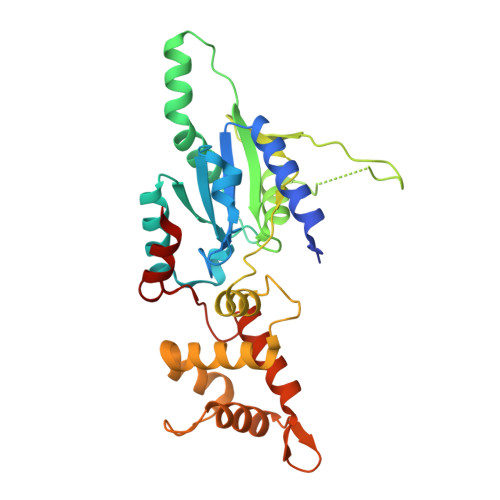Structural basis for (p)ppGpp-mediated inhibition of the GTPase RbgA.
Pausch, P., Steinchen, W., Wieland, M., Klaus, T., Freibert, S.A., Altegoer, F., Wilson, D.N., Bange, G.(2018) J Biological Chem 293: 19699-19709
- PubMed: 30366986
- DOI: https://doi.org/10.1074/jbc.RA118.003070
- Primary Citation of Related Structures:
6G0Z, 6G12, 6G14, 6G15 - PubMed Abstract:
Efficient adaptation to environmental changes is pivotal for all bacterial cells. Almost all bacterial species depend on the conserved stringent response system to prompt timely transcriptional and metabolic responses according to stress conditions and nutrient depletion. The stringent response relies on the stress-dependent synthesis of the second messenger nucleotides and alarmones (p)ppGpp, which pleiotropically target and reprogram processes that consume cellular resources, such as ribosome biogenesis. Here we show that (p)ppGpp acts on the ribosome biogenesis GTPase A (RbgA) of Gram-positive bacteria. Using X-ray crystallography, hydrogen-deuterium exchange MS (HDX-MS) and kinetic analysis, we demonstrate that the alarmones (p)ppGpp bind to RbgA in a manner similar to that of binding by GDP and GTP and thereby act as competitive inhibitors. Our structural analysis of Staphylococcus aureus RbgA bound to ppGpp and pppGpp at 1.8 and 1.65 Å resolution, respectively, suggested that the alarmones (p)ppGpp prevent the active GTPase conformation of RbgA by sterically blocking the association of its G2 motif via their 3'-pyrophosphate moieties. Taken together, our structural and biochemical characterization of RbgA in the context of the alarmone-mediated stringent response reveals how (p)ppGpp affects the function of RbgA and reprograms this GTPase to arrest the ribosomal large subunit.
- From the Department of Chemistry and Patrick.Pausch@synmikro.uni-marburg.de.
Organizational Affiliation:

















